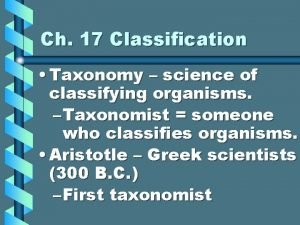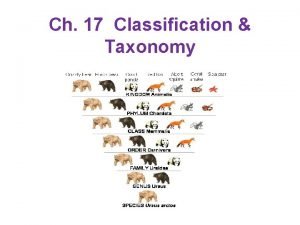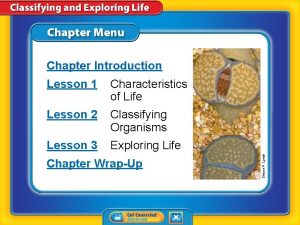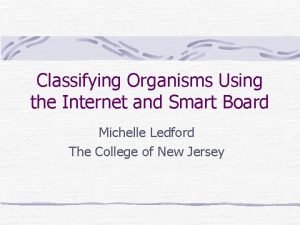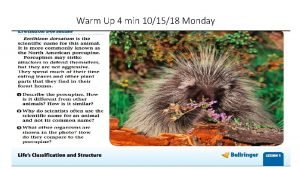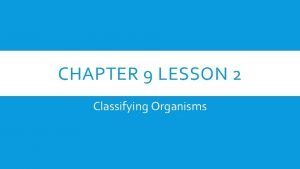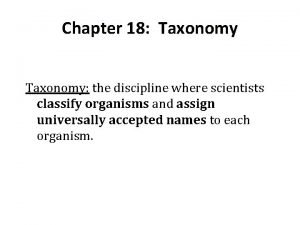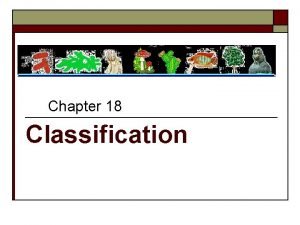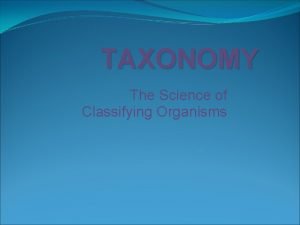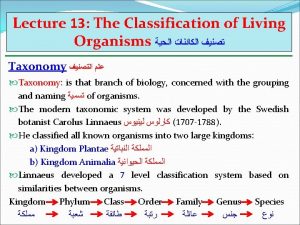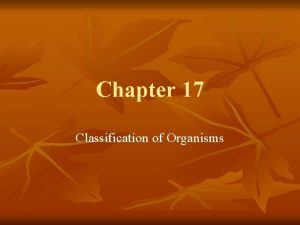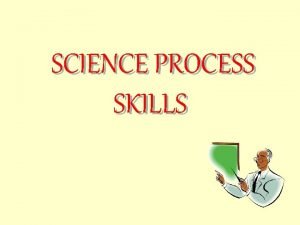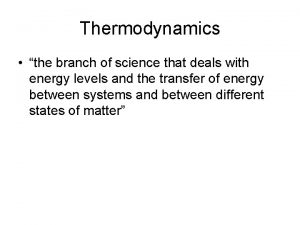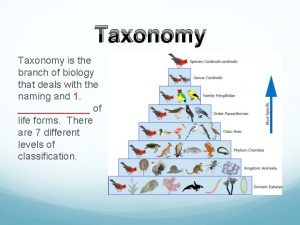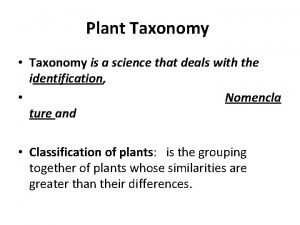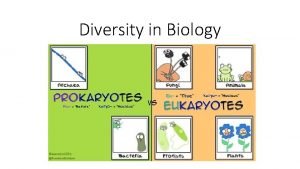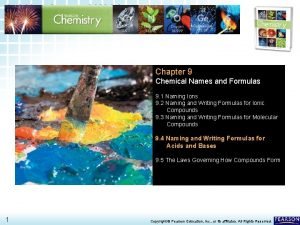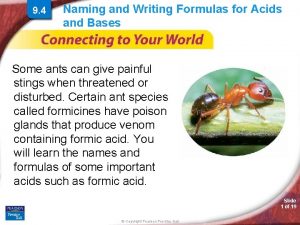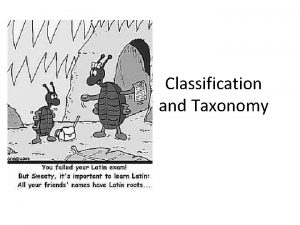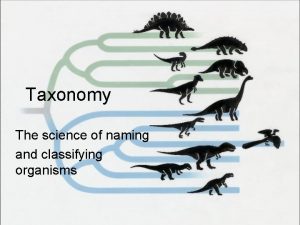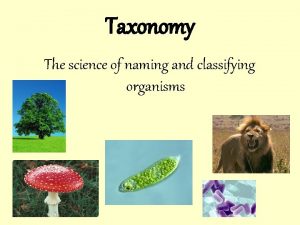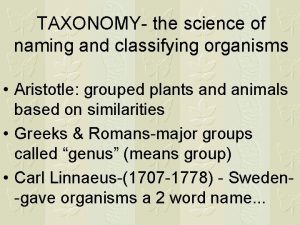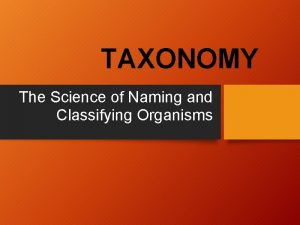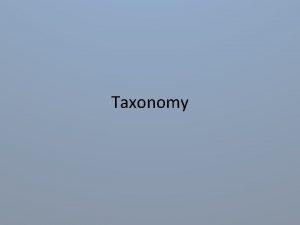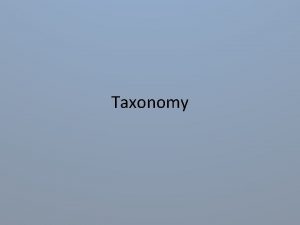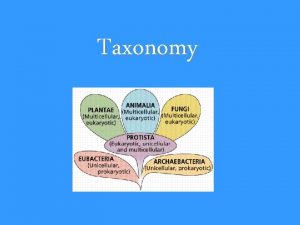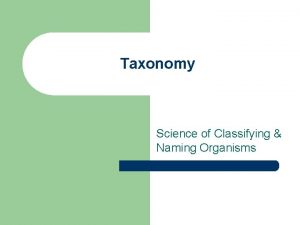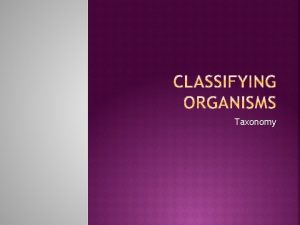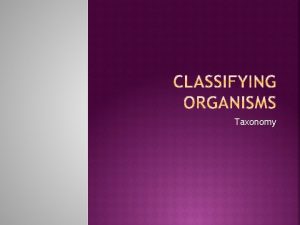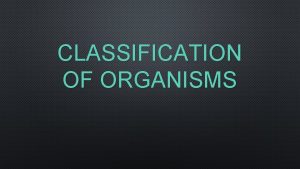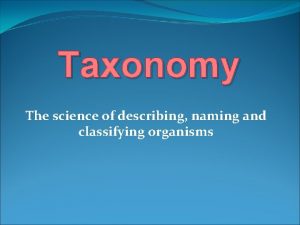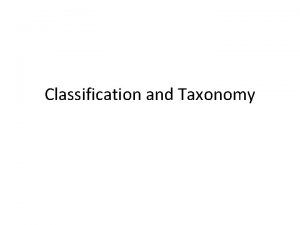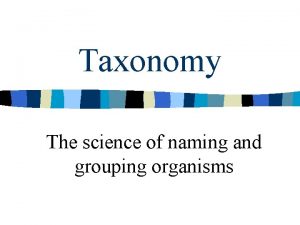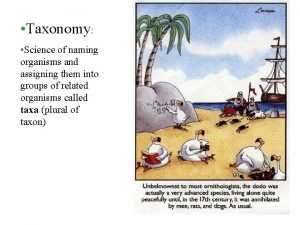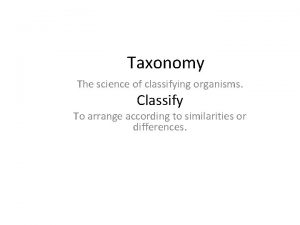Taxonomy The science of naming and classifying organisms


































- Slides: 34

Taxonomy The science of naming and classifying organisms

History of Classification • Learning Goal: Analyze the degree of relatedness among various species using taxonomic principles

Why Classify? • There are millions of organisms on earth • Scientists need a common language that all can understand (Latin) • Classification systems put species in order – Needs a universally accepted name for each species. – Members of each group would share important characteristics.

Linnaeus’ system • Swedish botanist in the 1700 s • Developed classification system still used today • Grouped organisms according to similar appearance and behavior • Members of one genus should be more closely related to each other than members of another genus

Binomial Nomenclature • Gives each species a scientific name that has two parts. – 1 st part = genus • Small group of similar organism – 2 nd part = specific name that identifies species • Named after important characteristic of each organism – Scientific names are in Latin!

Taxonomic Categories • Organisms are grouped according to broad characteristics and then by more specific criteria

Domain Kingdom Phylum Class Order Family Genus Species

Human Classification Domain Kingdom Phylum Class Order Family Genus Species Eukarya Animalia Chordata Mammalia Primates Hominidae Homo Sapiens

Species • Smallest taxon • Share similar characteristics and can breed with one another • Just because two organisms look alike they may not be of the same species

Ursus americanus American black bear Ursus thibetanus Asiatic black bear

Genus • Group of species that are closely related and share a common ancestor but cannot breed with one another

Family • Consist of organisms of similar, related genera • All elephants & mammoths are in the family Elephantidae

Dichotomous Keys • Tool that allows the user to determine the identity of items in the natural world. • Consist of a series of choices that lead the user to the correct name of a given item. • "Dichotomous" means "divided into two parts, “ therefore dichotomous keys always give two choices in each step.

Modern Classification • Learning Goal: Analyze the degree of relatedness among various species using taxonomic principles (phylogeny, morphology, DNA analysis and cladistics)

Phylogeny • The evolutionary history of a species • Defines species as a cluster of organisms that is distinct from other clusters and shows evidence of a pattern of ancestry and descent


Morphology • The form and structure of organisms • Shared form and structure suggest a common ancestor • Hawks & Eagles – good eyesight, hooked beaks, talons – Share a more recent comment ancestor with each other than penguins

DNA Analysis • Similar species share similar DNA – Greater number of shared DNA sequences = greater number of shared genes = greater likelihood of a common ancestor • Chromosomes structure and number = huge clue for determining species similarity

Human DNA vs. Other Species • • • Another human = 100% same Chimpanzee = 98% same Mouse = 92% same Fruit Fly = 44% same Wheat = 18% same

Molecular clock model • Used to compare DNA sequences from two different species to determine how long it has been since they diverged from a common ancestor • Differences between genes = mutations • More mutations = more time passed since divergence



Cladistics • Method that classifies organisms according to the order that they diverged from a common ancestor. • Considers: – Derived traits – Ancestral traits

Cladograms • Branching diagram that represents the proposed evolutionary history of a species or group.


Domains and Kingdoms • Largest taxa

Domain Bacteria • • Prokaryotes Have cell wall Can survive in many different environments More abundant than any other organism

Bacterial Shapes • • • spherical (cocci) rod (bacilli) spiral (spirilla) comma (vibrios) corkscrew (spirochaetes) single cells, in pairs, chains or clusters.

Domain Archaea • Prokaryotes • Extremophiles – live in extreme environments – Thermoacidophiles: hot acidic environments (around volcanoes, ocean vents, sulfur hot springs) – Halophiles: very salty environments – Methanogens: CANNOT live in the presence of oxygen. (sewage treatment plants, swamps)

Domain Eukarya • All eukaryotes • Contains 4 kingdoms: – Protista – Fungi – Plantae – Animalia

Kingdom Protista • Protists – stuff that doesn’t fit anywhere else! • 3 groups: – Algae: plantlike – Protozans: animal like – Slime molds: fungus like

Kingdom Fungi • Absorbs nutrients from organic material in its environment • Heterotrophs • Lack motility • Have cell walls • Over 400 million years old • 70, 000 known species

Kingdom Plantae • • • Form the basis for all habitats on land Multicellular Autotrophs (mostly) Have cell walls Cells are organized into tissues

Kingdom Animalia • • • More than one million species! Heterotrophs Multicellular Do not have cell walls Cells Tissues Organ Systems Animal
 Family genus species
Family genus species The science of naming and classifying organisms
The science of naming and classifying organisms Human order taxonomy
Human order taxonomy The scientific discipline of classifying organisms
The scientific discipline of classifying organisms Discipline of classifying and naming organisms
Discipline of classifying and naming organisms Discipline of classifying and naming organisms
Discipline of classifying and naming organisms Liger taxonomy
Liger taxonomy Name of organisms
Name of organisms Classification of living things quickchek
Classification of living things quickchek Marzano taxonomy verbs
Marzano taxonomy verbs Unicellular vs multicellular organisms
Unicellular vs multicellular organisms Classifying and exploring life lesson 2 answers
Classifying and exploring life lesson 2 answers Classifying organisms worksheet
Classifying organisms worksheet Lesson outline classifying organisms
Lesson outline classifying organisms Lesson 2 classifying organisms
Lesson 2 classifying organisms The scientific discipline of classifying organisms
The scientific discipline of classifying organisms Kingdom animalia cladogram
Kingdom animalia cladogram Dear king phillip came over
Dear king phillip came over Order of classification of organisms
Order of classification of organisms Organisms taxonomy
Organisms taxonomy Taxonomy in biology
Taxonomy in biology Member of the same species
Member of the same species Talk about your favorite subject
Talk about your favorite subject Classifying in science process skills
Classifying in science process skills Science process skills definition
Science process skills definition Thermodynamics is the branch of science that deals with
Thermodynamics is the branch of science that deals with Study of plants
Study of plants Taxonomy is the branch of science that deals with
Taxonomy is the branch of science that deals with Taxonomy is the science that deals with
Taxonomy is the science that deals with Crayfish taxonomy
Crayfish taxonomy Naming and writing formulas for acids and bases
Naming and writing formulas for acids and bases Introducing and naming new products and brand extensions
Introducing and naming new products and brand extensions Introducing and naming new products and brand extensions
Introducing and naming new products and brand extensions Naming and writing formulas for acids and bases
Naming and writing formulas for acids and bases Hình ảnh bộ gõ cơ thể búng tay
Hình ảnh bộ gõ cơ thể búng tay





